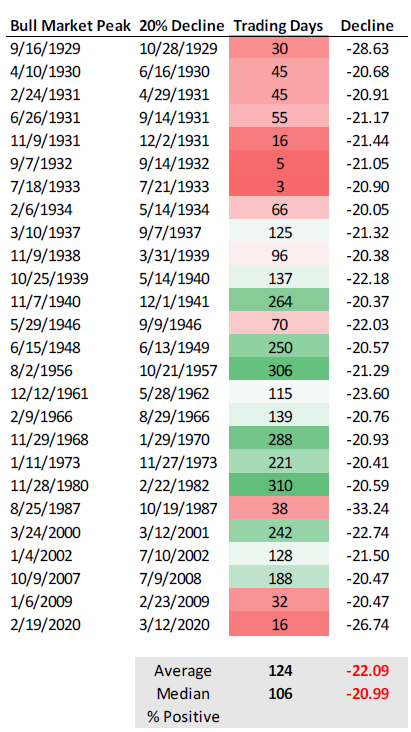Spring 2020 Menu of Contents:
- A Socially Distant World
- A Sudden End to the Bull Market
- The Fed and its Bazooka
- Government to the Rescue
- How Households and Businesses are Set to Benefit
- A New World
contact a member of the Withum Wealth Management group.
A Socially Distant World
We hope this commentary finds you and your loved ones in good health. The global Coronavirus (COVID-19) pandemic has certainly changed the world we live in today and perhaps for decades to come.
While certain parts of the world have seen progress after instituting measures to “flatten the curve” of confirmed coronavirus cases, it is likely we will see an increasing number of cases here in the U.S. as testing ramps up. Many states have instituted shelter in place restrictions and job shutdowns which should help slow the infection rate. Therefore, as disruption to individuals and businesses continues globally, the economy and business activity has dramatically slowed. The Federal Reserve believes we may see as many as 47 million people temporarily unemployed and the unemployment rate could spike to 32%. These are alarming forecasts, hopefully much of which is reflected in current stock prices. At this point, a global recession is unavoidable. The question now becomes how long and how deep it will be.
The force and the impact of the forthcoming fiscal stimulus (more on this later), coupled with monetary policy actions taken by the Federal Reserve should provide a meaningful, but far from a complete remedy to those individuals and businesses that are reeling from the sudden drop in economic activity. As you would expect, the U.S. healthcare industry has responded in full force. On March 30th, Johnson & Johnson announced it signed a $1 billion deal with the U.S. Government to produce a possible coronavirus vaccine; two days earlier Abbott Labs introduced a test that can detect the virus in five minutes. These breakthrough discoveries will go a long way in the global war on COVID-19. Our hope is that social distancing measures, the arrival of warmer weather and a continuation of medical breakthroughs will help save lives and eventually, in well-thought-out stages, allow all of us to return to some form of “normalcy” soon.
We are all in this together and we will come out of this stronger.
A Sudden End to the Bull Market
During the first quarter, we witnessed history in the making. The S&P 500 had the fastest bear-market decline (20% drop from a previous high) since 1933 and it lost over one-quarter of its value in 16 trading days. As the chart depicts, for periods outside the Great Depression, the average time it takes to reach these sorts of declines is 124 trading days. In other words, it typically takes over four months to reach bear market levels. This time, it took three weeks.

In our previous quarterly commentary, we shared our views regarding market complacency and discussed how “a series of unexpected data points, surprise developments or an exogenous shock can trigger a change in market psychology”. To that point, the market complacency has clearly been shattered—which in time should create future opportunities for market participants. The level of uncertainty today is extremely high as evidenced by the wild swings in market prices over the past few weeks. The peak to trough returns in the S&P500 have already exceeded the 30% average decline during a recessionary period. But, given elevated volatility and so many unknowns, any reasonable attempts to pick the market bottom could prove foolish. We prefer to use the market weakness to upgrade portfolio quality, harvest tax losses and ensure portfolios remain aligned with your unique set of goals.
The Fed and its Bazooka
The Federal Reserve has been very aggressive in its response to the coronavirus pandemic. Not only did it cut rates by 150 basis points (1.5%) but it also announced unlimited quantitative easing (QE) and purchase of Treasuries, mortgage securities, corporates and the launch of three new lending facilities to ensure liquidity in the short-term debt markets. This unprecedented level of ammunition against the tumult created by the coronavirus is what has been frequently referred to as the Fed’s bazooka.
Obviously, the Fed’s actions are an enormous help to keep the credit markets well oiled and hopefully allow sufficient time until we enter a period of more sustainable, normalized economic improvement. However, should conditions deteriorate, the Federal Reserve might have to venture further into unchartered territory or come out with additional ammunition which might prove challenging in our view. But, in Jerome Powell’s words: “The Federal Reserve still has room for more policy action.”
Stay tuned.
Government to the Rescue
The U.S. Congress recently enacted the “CARES Act”, a massive $2.2 trillion fiscal stimulus package aimed to help cushion the economic impact of the COVID-19 outbreak. To put this into perspective, in response to the global financial crisis, the American Recovery and Reinvestment Act of 2009 was about $800 billion.

The Expected Package has Three Main Goals:

Below We List Some Points Regarding How Households and Businesses are Set to Benefit:
- Direct payments to American households, $1,200 per adult and $500 per child for households, with phaseouts based on income levels.
- Extension of unemployment benefits to 39 weeks (from 26). This includes a $600/ week increase for the first four months.
- The bill also expands some benefits to independent contractors and other non-traditional workers. Relief for affected industries such as airlines, air cargo, and aerospace.
- Tax relief for businesses and individuals, including filing date delays.
- Small business loans that do not need to be repaid if used for wages or other necessities.
- Federal spending on hospitals and healthcare.
- State fiscal aid.
- Fed corporate and municipal credit facility for the Treasury’s Exchange Stabilization fund.
Please keep an eye out for our upcoming blog posts that address how the CARES Act can help individuals and small business owners through these difficult times. In addition, we will soon be blogging about Roth conversion and GRAT opportunities.
Fiscal and monetary policy responses have been swift and sizable. The table below summarizes major actions undertaken by a few developed economies. The new credit facilities section resembles alphabet soup but spells big time relief.
Source: GSAM
| Monetary Policy Actions: Developed Markets | ||||
| Policy Rate | Unconventional Policies | |||
| As of Jan. 1 | Current Rate | New Asset Purchases | New Credit Facilities | |
| U.S. | 1.50 – 1.75% | 0 – 0.25% | Announced buying a potentially uncapped amount of USTs and MBS |
CPFF, PDCF, MMLF, PMCCF, SMCCF, TALF, relaxed capital buffers, FX swap lines |
| Euro Area | -0.50% | -0.50% | EUR 120bn APP increase + EUR 750bn Emergency Programme |
FX swap lines, LTROs, more attractive TLTRO-III terms aimed at SMEs |
| U.K. | 0.75% | 10% | GBP 200bn new purchases, majority Gilts, “as soon as operationally possible” |
FX swap lines, TFS with additional incentives for SMEs, lowered countercyclical capital buffers to 0% |
| Japan | -0.10% | -0.10% | Expanded ETF purchase: BOJ doubling the annual upper limit to JPY 12tn temporarily |
|
| Fiscal Policy Actions: Developed Markets | ||||||
| Status | Discretionary Fiscal Easing | Loan Guarantees | Notes | |||
| Amount | %GDP | Amount | %GDP | |||
| U.S. | Planned | $1.6tn | 7.4% | $4tn | 19% | Three phases including small business loans, capital for loans and loan guarantees, payments to individuals, expanded unemployment insurance, fiscal aid to states, and federal spending. |
| Germany | Actual | EUR 626bn |
1.9% | up to EUR 953bn |
28% | Contingent funds for capital injections and corporate loans, guarantees on corporate debt securities, and loans through KfW bank. |
| U.K. | Actual | GBP 80bn | 3.5% | GBP 330bn |
15% | Includes extra resources for the NHS, sick pay measures, access to unemployment insurance, tax deferral, loan guarantees for working capital, and an ~80% wage subsidy for affected employees. |
| Japan | GS Forecast | JPY 6tn | 1.0% | Expect stimulus to mainly consist of income assistance through wage subsidies. |
||
A New World
Headline news such as alarming unemployment levels, more positive COVID-19 cases and related deaths will only get worse over the next few weeks. But as the world grapples with fear, uncertainty and loss of life, we are encouraged by our government’s pace to enact meaningful legislation as well as the swift response from the U.S. Federal Reserve. Unlike 2008, when the Federal Reserve and U.S. government were late to react, this time it’s different. Money will not cure the ill or stop the spread of the virus, but it can hopefully buy all of us time as we attempt to weather this unprecedented storm.
We take comfort (and some amazement) in seeing how effectively companies are managing as most of their workforce are working from home. We hope businesses remain open-minded to the employees that, for various reasons, will prefer to work from home when we return to some form of normalcy. This potential change in business mindset could prove profitable and increase the quality of life for many employees. One of the positive lessons that we should remember is that remote interactions are working and can work to some degree going forward.
We also gain comfort in knowing every major biotech and pharmaceutical company is working 24/7 on ways to accurately test for the virus and to create therapies and vaccines to confront it. This is a war time effort with companies ranging from the automobile industry, to major league baseball uniform manufacturers creating ventilators and first responder protective gear. It is also encouraging to see many individuals and small businesses contributing in different ways. As we said before, the world is not without risk, but it is full of compassion.
We are here for you should you have any questions related to your financial plan, your portfolio, or want to discuss current events. We are all in this together and will emerge stronger.
Withum Wealth Services
Important Disclosure: Please remember that past performance may not be indicative of future results. Different types of investments involve varying degrees of risk, and there can be no assurance that the future performance of any specific investment, investment strategy, or product (including the investments and/or investment strategies recommended or undertaken by Withum Wealth Management. [“WWM”] ), or any non-investment related content, made reference to directly or indirectly in this newsletter will be profitable, equal any corresponding indicated historical performance level(s), be suitable for your portfolio or individual situation, or prove successful. Due to various factors, including changing market conditions and/or applicable laws, the content may no longer be reflective of current opinions or positions. Moreover, you should not assume that any discussion or information contained in this article/newsletter serves as the receipt of, or as a substitute for, personalized investment advice from WWM. Please remember to contact WWM in writing, if there are any changes in your personal/financial situation or investment objectives for the purpose of reviewing/evaluating/revising our previous recommendations and/or services. WWM is neither a law firm nor a certified public accounting firm and no portion of the newsletter content should be construed as legal or accounting advice. A copy of the WWM current written disclosure statement discussing our advisory services and fees is available for review upon request.


